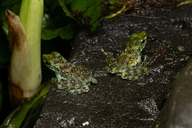|
Staurois parvus Inger & Haile, 1959
Lesser Rock Skipper (Haas et al. 2022) | family: Ranidae genus: Staurois |
| Species Description: Inger, R. F., and N. S. Haile. (1959). Two new frogs from Sarawak. Sarawak Museum Journal 9: 270–276. | |
|
Taxonomic Notes: Resurrected by: Matsui M, Mohamed M, Shimada T, Sudin A. (2007). Resurrection of Staurois parvus from S. tuberilinguis from Borneo (Amphibia, Ranidae). Zoological Science 24, 101-106 |
|
|
Etymology: In Latin, "parvus" means "small", which refers to Staurois parvus being the smallest species of the genus. |
|
 © 2024 Frederic Griesbaum (1 of 4)
|
|
|
|
Description Dorsal coloration is a dark brown to almost black, with irregular light-brown blots. The top of the three inner toes and the respective upper webbing are blueish white. The belly is blueish white, and the chest and belly are white (with dark spots in females) (Inger et al. 2017). Juveniles are green, with irregular dark markings all over the body (Preininger, pers. comm.). Distribution and Habitat Country distribution from AmphibiaWeb's database: Brunei Darussalam, Indonesia, Malaysia Malaysian region distribution from AmphibiaWeb's database: Sabah, Sarawak
Life History, Abundance, Activity, and Special Behaviors Male S. parvus exhibit a wide range of visual displays, with foot flagging being the most common and conspicuous. Foot flagging involves raising and rotating the leg to expose the white webbing between the toes and lasts an average of 1.56 seconds. Less frequent displays include foot flashing, arm waving, upright or crouched postures, and open-mouth displays (Grafe et al. 2012). Females also perform visual signals like foot flagging and upright postures, and one tactile interaction (“leg-snout touch”) was observed, where a male extended his leg to touch a female’s snout in a possible courtship context. The purpose of these signals appears to vary between intra- and intersexual communication, but some interactions, such as the leg-snout touch, remain unclear (Grafe et al. 2012). The advertisement call consists of 1 - 35 high-pitched notes, which get higher and faster towards the end (Inger et al. 2017). Females also vocalize from time to time and show release calls in some cases when males attempt to mate. It sometimes occur in sympatry with Staurois guttatus (Matsui et al. 2007). Larva The lotic tadpoles are similar to the ones of S. gutattus (Inger et al. 2017) and other known Staurois larvae. The tapoles are mostly unpigmented. The transparent skin makes them look reddish as the organs shine though. However, on the dorsum there is a slight band of dark pigments from the head to the end to the tail muscle. Furthermore, the skin shows a bluish iridescence in life specimens (Grosjean and Preininger 2020, Haas et al. 2022). Trends and Threats Tiergarten Schönbrunn (Zoo) in Vienna successfully breeds the species (Preininger et al. 2012) under the lead of Doris Preininger and together with Citizen Conservation (https://citizen-conservation.org) they created an ex-situ conservation program for S. parvus. Possible reasons for amphibian decline General habitat alteration and loss Comments References Grafe, T. U., Preininger, D., Sztatecsny, M., Kasah, R., Dehling, J. M., Proksch, S., and Hödl, W. (2012). Multimodal communication in a noisy environment: a case study of the Bornean rock frog Staurois parvus. PloS one, 7(5), e37965. [link] Grosjean, S., and Preininger, D. (2020). Description of two Staurois tadpoles from Borneo, Staurois parvus and Staurois tuberilinguis (Anura: Ranidae). Zootaxa, 4896(4), 523-534. [link] Haas, A., I. Das, S. T. Hertwig, P. Bublies, and R. Schulz-Schaeffer (2022). A Guide to the Tadpoles of Borneo (eBook version). Hamburg, Germany. Tredition.Inger, R. F., and N. S. Haile (1959). Two new frogs from Sarawak. Sarawak Museum Journal 9, 270–276. Inger, R. F., Stuebing, R. B., Grafe, U., and Dehling, J. M. (2017). A Field Guide to the Frogs of Borneo. Natural History Publications (Borneo) Limited, Kota Kinabalu. IUCN SSC Amphibian Specialist Group. (2018). Staurois parvus. The IUCN Red List of Threatened Species 2018: e.T135759A97518102. https://dx.doi.org/10.2305/IUCN.UK.2018-1.RLTS.T135759A97518102.en. Accessed on 29 November 2024. Matsui, M., Mohamed, M., Shimada, T., and Sudin, A. (2007). Resurrection of Staurois parvus from S. tuberilinguis from Borneo (Amphibia, Ranidae). Zoological Science. Tokyo 24(1), 101–106. [link] Preininger, D., Weissenbacher, A., Wampula, T., and Hödl, W. (2012). The conservation breeding of two foot-flagging frog species from Borneo, Staurois parvus and Staurois guttatus. Amphib Reptile Conserv, 5, 45-56. [download]Originally submitted by: Frederic Griesbaum (2024-12-06) Description by: Frederic Griesbaum (updated 2024-12-06)
Distribution by: Frederic Griesbaum (updated 2024-12-06)
Life history by: Frederic Griesbaum (updated 2024-12-06)
Larva by: Frederic Griesbaum (updated 2024-12-06)
Trends and threats by: Frederic Griesbaum, Ann T. Chang (updated 2024-12-06)
Comments by: Frederic Griesbaum, Ann T. Chang (updated 2024-12-06)
Edited by: Ann T. Chang (2024-12-13) Species Account Citation: AmphibiaWeb 2024 Staurois parvus: Lesser Rock Skipper (Haas et al. 2022) <https://amphibiaweb.org/species/6906> University of California, Berkeley, CA, USA. Accessed May 31, 2025.
Feedback or comments about this page.
Citation: AmphibiaWeb. 2025. <https://amphibiaweb.org> University of California, Berkeley, CA, USA. Accessed 31 May 2025. AmphibiaWeb's policy on data use. |




 Map of Life
Map of Life